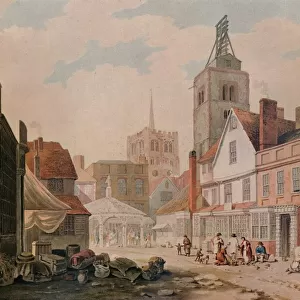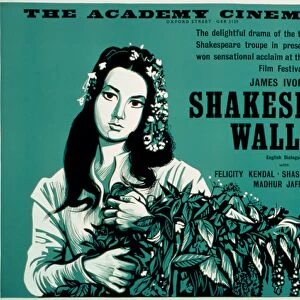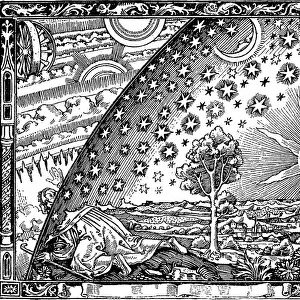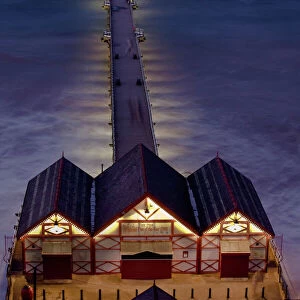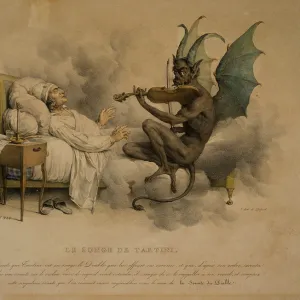Home > Europe > United Kingdom > England > Cleveland
Yaja and Upayaja perform a sacrifice for the emergence of Dhrishtadyumna from the fire
![]()

Wall Art and Photo Gifts from Heritage Images
Yaja and Upayaja perform a sacrifice for the emergence of Dhrishtadyumna from the fire
Yaja and Upayaja perform a sacrifice for the emergence of Dhrishtadyumna from the fire, from Adi-parva (volume one) of the Razm-nama (Book of Wars) adapted and translated into Persian by Mir Ghiyath al-Din Ali Qazvini, known as Naqib Khan (Persian, d. 1614) from the Sanskrit Mahabharata, 1598. Fire sacrifice was central to the Indo-European people who entered the Indian subcontinent as early as 1800 BC. Only Brahmins, a social class of priests, had access to the sacred texts called the Vedas, which explained the meaning and process of the fire sacrifice, considered by orthodox Hindus as a way to communicate with the gods. A king named Drupada in ancient India sponsored this fire sacrifice in order to generate a powerful warrior who would be able to slay the enemy who took half his kingdom. Seated around an altar in the sacrificial enclosure, Brahmins pour oblations into the fire and recite the prayers necessary to generate the divine warrior Dhrishtadyumna, shown here in full battle armor at birth. The inscription below gives the title and the name of the artist, Habshi, which means " Ethiopian, " suggesting the presence of Africans in the royal Mughal workshop. The story of how the warrior Dhrishtadyumna was generated from the fire sacrifice is written on this page. When King Drupada lost half his kingdom to a military master named Drona, he needed a gift from the gods to defeat him: a new warrior born to accomplish this mission. In order to obtain this gift, King Drupada went to the banks of the Ganges to find two powerful Brahmins to whom the gods would respond favorably. After serving them faithfully and offering payment of 100, 000 cows, the Brahmins Yaja and Upayaja agreed to perform the sacrifice. The text is written in a form of Arabic script, called naskh, in the Persian language, as translated from the original Sanskrit epic Mahabharata for emperor Akbar (r. 1556-1605). The passages of dialogue are written diagonally
Heritage Images features heritage image collections
Media ID 19649035
© Heritage Art/Heritage Images
Attributed To Late 16th Century Mughal Opaque Watercolour With Gold On Paper Text On Verso
FEATURES IN THESE COLLECTIONS
> Animals
> Farm
> Cattle
> Related Images
> Arts
> Artists
> Related Images
> Asia
> India
> Related Images
> Europe
> United Kingdom
> England
> Cleveland
EDITORS COMMENTS
The print captures a significant moment in ancient Indian history, depicting the fire sacrifice performed by Yaja and Upayaja for the emergence of Dhrishtadyumna. This scene is taken from Adi-parva (volume one) of the Razm-nama (Book of Wars), which was adapted and translated into Persian by Mir Ghiyath al-Din Ali Qazvini, also known as Naqib Khan. Fire sacrifice held immense importance for the Indo-European people who migrated to India around 1800 BC. Only Brahmins, belonging to a social class of priests, had access to the sacred texts called Vedas that explained the meaning and process behind this ritual. It was considered a way for orthodox Hindus to communicate with their gods. In this particular instance, King Drupada sponsored the fire sacrifice in hopes of generating a powerful warrior capable of reclaiming his lost kingdom from an enemy named Drona. Seated around an altar within the sacrificial enclosure, Brahmins pour oblations into the fire while reciting prayers necessary for summoning Dhrishtadyumna. The inscription below reveals that Habshi, meaning "Ethiopian" is credited as the artist responsible for this artwork. This suggests African presence within Mughal workshops during that time. This page not only showcases Habshi's artistic talent but also narrates how King Drupada sought divine intervention through this ritualistic act. The text is written in naskh script, a form of Arabic script used to translate passages from Sanskrit epic Mahabharata into Persian language specifically for Emperor Akbar during his reign from 1556-1605.
MADE IN THE USA
Safe Shipping with 30 Day Money Back Guarantee
FREE PERSONALISATION*
We are proud to offer a range of customisation features including Personalised Captions, Color Filters and Picture Zoom Tools
SECURE PAYMENTS
We happily accept a wide range of payment options so you can pay for the things you need in the way that is most convenient for you
* Options may vary by product and licensing agreement. Zoomed Pictures can be adjusted in the Cart.


